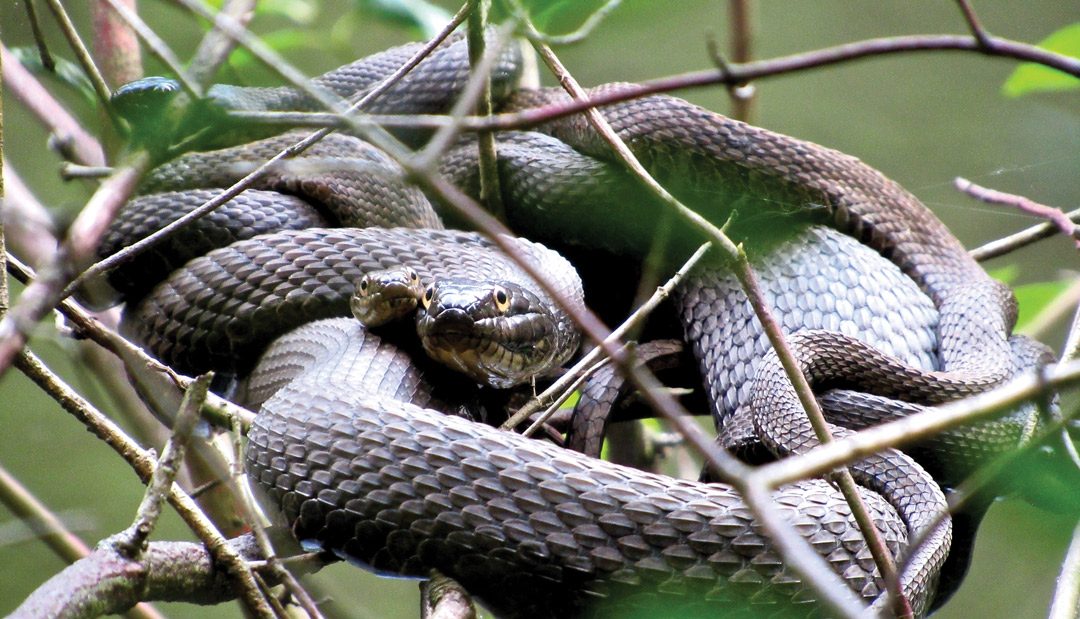Written by Pam Varga
Most people shudder or even scream in fear or disgust when they see a snake, but I think snakes are amazing.
A few days ago, I watched Izzy,our resident four-foot Northern Water Snake, swim across the pond. She glided smoothly across the surface of the water by twisting her body back and forth. Izzy raised her head, then dove under the water and disappeared. Snake scan swim on the water, dive and swim under water, climb trees, burrow underground, and crawl rapidly across the ground, all without having arms, legs, paws, claws, feet, flippers or fins. Now that’s pretty amazing! Could you do that?
Why are people afraid of snakes? Some people think snakes are slimy and slippery. A snake’s skin is covered with overlapping scales like shingles on a roof. The scales protect the snake’s skin and keep it from drying out. A snake actually feels dry and smooth, almost like plastic. The snake’s skin doesn’t grow along with its body,so periodically, the snake sheds its skin. This is also called molting. Just before shedding, the skin looks dusty gray and the eyes look cloudy. The snake rubs against a solid object such as a rock or branch and slips out of belly. This arrangement makes the body extremely flexible and helps the snake to contract its body and grip with its belly scales to swim,crawl and climb. Some people are frightened by a snake’s intense unblinking stare. Actually, a snake can’t blink because it doesn’t have any eyelids! The eyes are protected by a transparent eye cap called the brille. Although a snake’s eyesight is keen and sensitive to motion, they do not its s k i n turning it inside out. Even the thin skin over the eye is shed. If you find a shed skin, it feels dry and papery, and you can see the pattern of the scales and details of the face.
A snake’s body is so flexible that many people think it has no bones. Just like you, the snake has a spine made up of vertebrae (backbones) that extend from the base of the skull to the bottom of your rear end,or in the case of the snake, to the very tip of its tail. Snakes can have hundreds of vertebrae while humans have only 24. Each vertebra is attached to a pair of ribs which is in turn attached to muscles that move the scales on the snake’s belly. This arrangement makes the body extremely flexible and helps the snake to contract its body and grip with its belly scales to swim, crawl and climb.
Some people are frightened by a snake’s intense unblinking stare. Actually, a snake can’t blink because it doesn’t have any eyelids!
The eyes are protected by a transparent eye cap called the brille. Although a snake’s eyesight is keen and sensitive to motion, they do not have good distance vision. So,that intense stare is just the snake’s way of keeping an eye on you.
When a snake flicks its tongue in and out, it isn’t getting ready to bite you as some people believe. The delicate moist tongue is used for tasting and smelling. A snake smells with its tongue! As the tongue darts in and out, it collects particles in the air. A small chemical receiver called Jacobson’s organ, located in the back of the mouth identifies the particles and sends messages of taste/smell to the brain. This sensitive, well-developed way of “smelling” helps the snake detect enemies, find food, and find a mate. The flickering tongue is smelling you to help the snake figure out what you are.
Snakes also do not have external ears or internal ear drums like you do. They sense vibrations through their lower jaws. This way of “hearing” can sense your approaching footsteps so the snake can quickly get out of your way.
Many people are afraid of being bitten by a snake. Do snakes bite? Yep, like any wild animal that is disturbed or feels threatened, snakes will strike and bite, but they don’t lay in wait ready to ambush you. Snakes don’t want to have anything to do with humans! Snakes have teeth that are used for grasping and holding, but not for chewing. Venomous snakes have hollow fangs that inject venom when they bite. There are three venomous snakes in Pennsylvania. The Eastern Massasaugua Rattlesnake, an endangered species rarely seen,is found only in 5 or 6 counties in west central Pa. and into Ohio. The Timber Rattlesnake, a much larger rattler reaching 36 – 54 inches, is found in the central part of the state.
The Northern Copperhead has a distinct copper color with hour-glass shaped brown or reddish-brown bands. Copperheads are found in most of Pa., except for across the northern part of the state. They prefer to live in rocky areas near streams or swamps and are sometimes found in abandoned farms, rock piles, and fallen logs. There are no venomous snakes at Sahli Park.
Several species of snakes have been spotted our park. Izzy is the largest of our Northern Water Snakes. These snakes have reddish,brown, gray and black bands. In adult snakes the pattern fades to gray and the colors are hard to see. Northern Water Snakes tend to have a temper and will strike repeatedly if threatened. Last year, a beautiful little Eastern Garter Snake lived in the greenhouse. We would often find him curled up in a potted plant or stretched out along the back of the sink. Gatsby was shiny black with three yellowish green stripes down his body. A Northern Brown Snake, sometimes called Dekay’s Snake, and a Northern Ringneck Snake also live outside the greenhouse. Both are small shy snakes.
Snakes may not be cute and cuddly, but they are amazing. Most of the time, you will never see a snake at the park, but if you do, don’t be afraid. Take a moment to appreciate the beauty and amazing anatomy of our reptile residents.







